Survey quotas: Difference between revisions
From LimeSurvey Manual
No edit summary |
mNo edit summary |
||
| Line 20: | Line 20: | ||
<!--T:7--> | <!--T:7--> | ||
Quotas do not automatically exclude respondents based on their answers. Think of a survey that contains | Quotas do not automatically exclude respondents based on their answers. Think of a survey that contains a "Yes or No" question and an Array question, each belonging to a separate question group. You set a quota on this survey that contains a restriction of 20 users who have answered "Yes" to this question. The quota will be checked every time somebody answers "Yes" to that question. | ||
Depending on the format of your survey (how the questions are displayed to your respondents) , the '''check''' happens either when you submit: | Depending on [[General_settings#General_settings_panel|the format of your survey]] (how the questions are displayed to your respondents), the '''check''' happens either when you submit: | ||
*'''the whole survey:''' If the format of the survey is ''all in one'', the questions | *'''the whole survey:''' If the format of the survey is ''all in one'', the survey questions (regardless of the question group they belong to) will be displayed on the same page. Therefore, the user has to press the submit button in order to trigger the quota system. | ||
*'''the answers to that specific question group:''' If the format of the survey is ''group by group'', then the quota gets activated when the user has responded to all the questions from the question group where the quota is located in. Therefore, the | *'''the answers to that specific question group:''' If the format of the survey is ''group by group'', then the quota gets activated when the user has responded to all the questions from the question group where the answer that contains the quota is located in. Therefore, the quota may get triggered before the end of the survey if the survey group is located at the beginning of the survey. | ||
*'''or the answer to that specific question:''' If the format of the survey is ''question by question'', the | *'''or the answer to that specific question:''' If the format of the survey is ''question by question'', each question will have a page allocated. If you select the answer of the questions to which the quota is applied to, the quota will get automatically activated once you press the '''Next''' button. | ||
{{To change the format of a survey, access the [[General settings|general settings of your survey]] from the survey settings menu.}} | |||
<!--T:8--> | <!--T:8--> | ||
| Line 37: | Line 37: | ||
<div class="simplebox">[[File:help.png]] '''Note:''' If you would like your respondents to answer certain survey questions according to a previous answer, use the LimeSurvey [[Expression Manager|expression manager]].</div> | <div class="simplebox">[[File:help.png]] '''Note:''' If you would like your respondents to answer certain survey questions according to a previous answer, use the LimeSurvey [[Expression Manager|expression manager]].</div> | ||
== | ==Using more answers and quotas== <!--T:12--> | ||
<!--T:13--> | <!--T:13--> | ||
| Line 57: | Line 57: | ||
*'''List (Dropdown)''' | *'''List (Dropdown)''' | ||
*'''List with comments''' | *'''List with comments''' | ||
=Survey quotas panel= | =Survey quotas panel= | ||
| Line 86: | Line 87: | ||
*'''Selected quota(s)...:''' It works like an aggregator. If you wish to apply one of the actions specified below to more than one quota, use this button to fasten the process. | *'''Selected quota(s)...:''' It works like an aggregator. If you wish to apply one of the actions specified below to more than one quota, use this button to fasten the process. | ||
<center>[[File:Survey quotas - Selected quota(s).png]]</center> | <center>[[File:Survey quotas - Selected quota(s).png]]</center> | ||
**''Activate:'' Use this button to activate a quota. The active ones have the quota name, action, and URL written in white font on a green background. | **''Activate:'' Use this button to activate a quota. The active ones have the quota name, action, and URL written in white font on a green background. | ||
<center>[[File:Active quota.png]]</center> | <center>[[File:Active quota.png]]</center> | ||
**''Deactivate:'' Use this button to deactivate a quota. The deactivated ones have the quota name and action written in black font on a grey background. | **''Deactivate:'' Use this button to deactivate a quota. The deactivated ones have the quota name and action written in black font on a grey background. | ||
<center>[[File:Deactivated quota.png]]</center> | <center>[[File:Deactivated quota.png]]</center> | ||
**''Change texts:'' Use this button to quickly change the quota message, URL, and URL description of a group of a quotas. You may use this function to redirect respondents to a certain link once different quota conditions were met. | **''Change texts:'' Use this button to quickly change the quota message, URL, and URL description of a group of a quotas. You may use this function to redirect respondents to a certain link once different quota conditions were met. | ||
<center>[[File:Survey quotas - change texts.png]]</center> | <center>[[File:Survey quotas - change texts.png]]</center> | ||
**''Delete:'' If you wish to delete several quotas in the same time, tick the ones you wish to delete, click on the selected quota(s) button and select the '''Delete''' option. | **''Delete:'' If you wish to delete several quotas in the same time, tick the ones you wish to delete, click on the selected quota(s) button and select the '''Delete''' option. | ||
==Add new quota== | ==Add new quota== | ||
| Line 118: | Line 128: | ||
*'''URL:''' The URL displayed to survey participants after the quota action was triggered. The users can also be automatically redirected to this URL if "Autoload URL" is enabled. You can use [[URL fields]] in this section. | *'''URL:''' The URL displayed to survey participants after the quota action was triggered. The users can also be automatically redirected to this URL if "Autoload URL" is enabled. You can use [[URL fields]] in this section. | ||
*'''URL Description:''' A short URL description can be added in order to show to the other survey administrators the goal of the URL for example. | *'''URL Description:''' A short URL description can be added in order to show to the other survey administrators the goal of the URL for example. | ||
===Add an answer=== | ===Add an answer=== | ||
| Line 142: | Line 153: | ||
In this example. the "Male" answer will have the quota applied to it whenever respondents choose it (+they finish completing the survey). | In this example. the "Male" answer will have the quota applied to it whenever respondents choose it (+they finish completing the survey). | ||
==Adding multiple quotas for the same question and subquestion== <!--T:24--> | ==Adding multiple quotas for the same question and subquestion== <!--T:24--> | ||
| Line 149: | Line 161: | ||
==Quick CSV report== | ==Quick CSV report== | ||
The quick | The quick CSV report function is used to export the survey quotas table in a comma-delimited CSV file. It includes the following fields: | ||
*'''Quota name:''' The name of the | *'''Quota name:''' The name of the quotas; | ||
*'''Limit''': The maximum number of responses; | *'''Limit''': The maximum number of responses marked as being "complete" in the survey responses table ; | ||
*'''Completed:''' The number of answers marked as | *'''Completed:''' The number of answers marked as being "complete". An answer is marked as being "incomplete" if the quota is triggered. | ||
*'''Remaining:''' | *'''Remaining:''' The number of answers that can still be collected in the survey responses table and marked as beingw "complete" there. | ||
=Quota and tokens= <!--T:29--> | =Quota and tokens= <!--T:29--> | ||
| Line 164: | Line 177: | ||
=Examples= | =Examples= | ||
== | The role of the following examples is to better explain the role of quotas and their usage within the LimeSurvey environment. Before continuing reading the below examples, please not that: | ||
* answers added in the same quota have are getting cumulated. For example, if answers A and B are added to quota Q1 from any avaiable survey question that supports quota, the quota limit will be reached by '''summing up''' the number of users who have answered A and B. | |||
* answers added in different quotas act as there is a logical operator "AND" | |||
==Add more answers to different quotas== | |||
Let's assume that you are doing a survey about LimeSurvey and you would like to receive some feedback from your users. You would like to receive 1000 answers from students and another 1000 from other categories of people (unemployed, self-employed or full-time employed). In order to do this, create two quotas: '''Students quota''' and '''Non-students quota'''. | |||
[[File:]] | |||
[[File:]] | |||
Now, add the answers to each quota box following the steps described .... . The quota boxes should look like this: | |||
[[File:]] | |||
[[File:]] | |||
By using this method, you limit the number of responses you receive from the two defined groups: students and non-students groups. | |||
== | ==Adding a URL link=== | ||
Revision as of 16:26, 14 November 2017
Introduction
A quota is used to set a limit on responses from defined groups of people on an active survey. Some common attributes used in defining quotas are things like gender, age, race, province/state. To access the survey quotas panel, access the survey menu and select the Survey quotas tab:
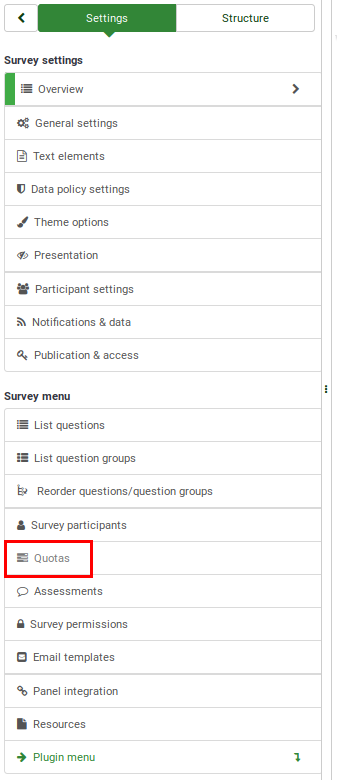
How do quotas work
Quotas do not automatically exclude respondents based on their answers. Think of a survey that contains a "Yes or No" question and an Array question, each belonging to a separate question group. You set a quota on this survey that contains a restriction of 20 users who have answered "Yes" to this question. The quota will be checked every time somebody answers "Yes" to that question.
Depending on the format of your survey (how the questions are displayed to your respondents), the check happens either when you submit:
- the whole survey: If the format of the survey is all in one, the survey questions (regardless of the question group they belong to) will be displayed on the same page. Therefore, the user has to press the submit button in order to trigger the quota system.
- the answers to that specific question group: If the format of the survey is group by group, then the quota gets activated when the user has responded to all the questions from the question group where the answer that contains the quota is located in. Therefore, the quota may get triggered before the end of the survey if the survey group is located at the beginning of the survey.
- or the answer to that specific question: If the format of the survey is question by question, each question will have a page allocated. If you select the answer of the questions to which the quota is applied to, the quota will get automatically activated once you press the Next button.
{{To change the format of a survey, access the general settings of your survey from the survey settings menu.}}
If "No" is chosen, the quota system is never triggered. Therefore, the survey won't restrict anyone from responding the rest of the questions, unless otherwise specified.
To set a limit on the number of "No" responses, you need to add an additional quota, restricting the number of participants who choose "No".
Using more answers and quotas
You might have to conduct a survey where you want to limit it to 25 male and 30 female respondents. You could then define a quota with a limit of 25 for the answer "Male" from your gender question in the survey. Another quota for the answer "Female" with a limit of 30 could be added as well. This will give you a maximum of 25 males who will be able to complete the survey, and a maximum of 30 females who can complete the survey.
Let's suppose now that you want 50 answers from males and 50 answers from females. Please note that each answer that triggers the quota must be introduced in its own quota box. Adding the two answers in the same box will result in collecting 50 answers, regardless of the gender of the respondent (the distribution can be 40 males and 10 females, or 20 males and 30 females, and so on). See the Example subsection to better understand the usage of the quota system.
Supported question types
The quota system can be applied only to the following types of questions at the moment:
- Gender
- Multiple Choice
- Array - 5 Point Choice
- Array - 10 Point Choice
- Language Switch
- Yes/No
- List (Radio)
- List (Dropdown)
- List with comments
Survey quotas panel
Once you click on the Survey quotas tab from the survey menu, the following page will load up:

To see the full set of options of this panel, add one survey quota. Then, the survey quota page will look like this:

The following options are available:
- Add new quota: Located on the bottom right part of the survey quotas table, it allows users to add new quotas. Once quotas are displayed on the table, you can start implementing them to certain questions/subquestions answers;
- Add an answer: Before adding an answer, you need to add a quota within which the answer(s) will be stored in. The quota limit will be applied only to those answers displayed in the quota box.
- Edit quota: Click on the green pencil located under the Action column of the survey quotas table to edit the fields of a quota;
- Delete quota: Click on the red trash button located under the Action column of the survey quotas table to delete the respective quota entry;
- Quota validation: Click on the last button located under the Action column of the survey quotas table to quickly check the quota message displayed to the respondents, the URL (and/or a short description of it) where they will be redirected;
- Quick CSV report: It exports a summary of the quotas under the form of a CSV comma-delimited table.
- Selected quota(s)...: It works like an aggregator. If you wish to apply one of the actions specified below to more than one quota, use this button to fasten the process.
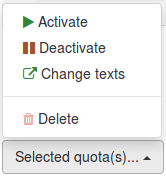
- Activate: Use this button to activate a quota. The active ones have the quota name, action, and URL written in white font on a green background.

- Deactivate: Use this button to deactivate a quota. The deactivated ones have the quota name and action written in black font on a grey background.

- Change texts: Use this button to quickly change the quota message, URL, and URL description of a group of a quotas. You may use this function to redirect respondents to a certain link once different quota conditions were met.
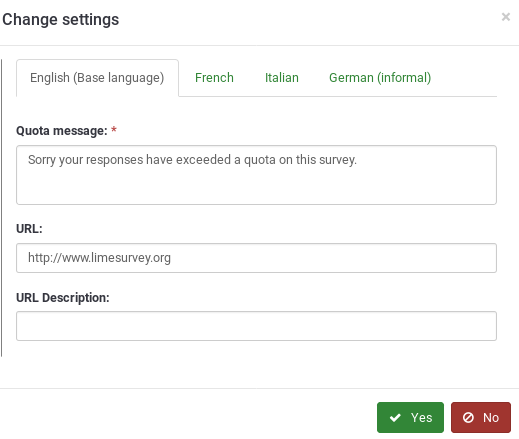
- Delete: If you wish to delete several quotas in the same time, tick the ones you wish to delete, click on the selected quota(s) button and select the Delete option.
Add new quota
For a fully working quota you must firstly "add a quota", and then "add answers" to that quota.
Once you click on the Add new quota button, the following page will be displayed:
The fields marked with a star have to be filled in.
The following options are available:
- Quota Name: This represents the name of the quota that will be displayed on the survey quotas table. It should describe the quota it will represent;
- Quota Limit: It represents the maximum number of completed surveys that will be stored in the responses table. The limit will be checked every time a certain answer is selected and the whole survey is completed;
- Quota Action: This is an action to perform when a participant is filling out a survey and lands up being part of a quota that has become full.
- Terminate survey: This immediately terminates the survey, and closes the interview.
- Allow user to modify his last answers before terminate survey:" Useful action when you want a respondent not to sign up/choose anymore a certain category. For example, when goodies are offered, you can use a quota on each goodie option in order not to have more users selecting the same good.
- Autoload URL: This tells LimeSurvey to automatically redirect the participant to the URL when the quota action occurs.
- Quota Message: Write the text you wish to be displayed to your respondents if the quota action is triggered.
- URL: The URL displayed to survey participants after the quota action was triggered. The users can also be automatically redirected to this URL if "Autoload URL" is enabled. You can use URL fields in this section.
- URL Description: A short URL description can be added in order to show to the other survey administrators the goal of the URL for example.
Add an answer
Once the quota was created, you can start adding answers under it. To do that, access the Survey quotas panel. Look into the survey quotas table and select the Add answer option from the quota box where you wish to add the respective answer to:
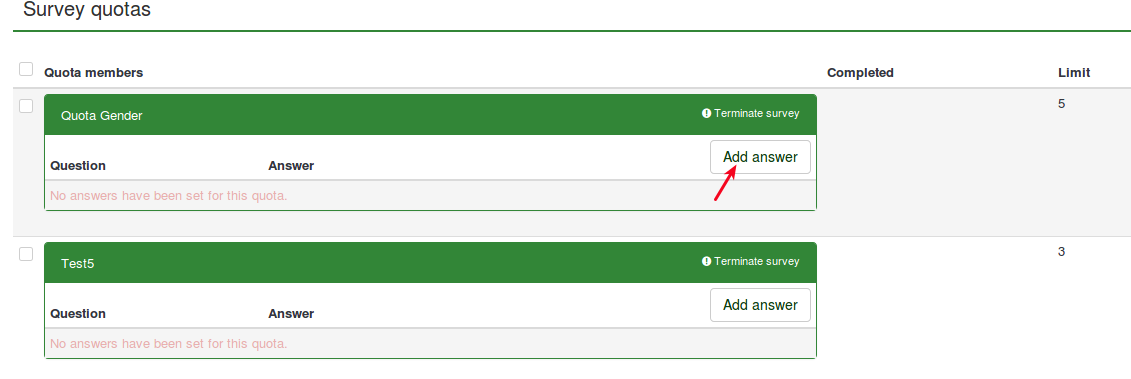
After you clicked it, a new page will load up which will ask you to select the question to which the quota will be applied to:
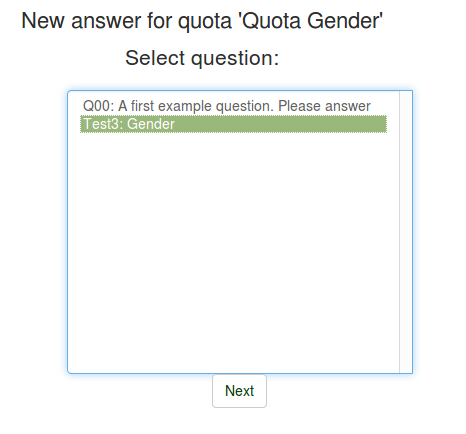
Once you click next, the answers of the question you selected one step before will be displayed. Now, you have to choose to which answer you wish the quota to be applied to:
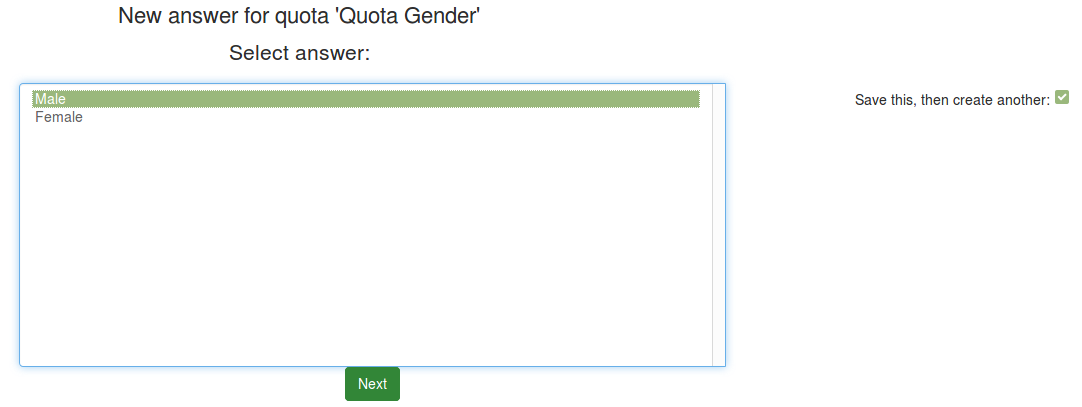
In this example. the "Male" answer will have the quota applied to it whenever respondents choose it (+they finish completing the survey).
Adding multiple quotas for the same question and subquestion
Adding N (a random number) quotas for the same question is possible. However, keep in mind that quotas are checked with a logical "AND" operator. Therefore, to meet the quota, all the N quota limits applied to that certain question/subquestion have to be reached.
Quick CSV report
The quick CSV report function is used to export the survey quotas table in a comma-delimited CSV file. It includes the following fields:
- Quota name: The name of the quotas;
- Limit: The maximum number of responses marked as being "complete" in the survey responses table ;
- Completed: The number of answers marked as being "complete". An answer is marked as being "incomplete" if the quota is triggered.
- Remaining: The number of answers that can still be collected in the survey responses table and marked as beingw "complete" there.
Quota and tokens
When tokens are used in a survey and the user is screened out due to a quota, then the according token entry is marked with the letter "Q" in the Completed column. That way the token is invalidated and the survey participant can't re-start the survey.
Examples
The role of the following examples is to better explain the role of quotas and their usage within the LimeSurvey environment. Before continuing reading the below examples, please not that:
- answers added in the same quota have are getting cumulated. For example, if answers A and B are added to quota Q1 from any avaiable survey question that supports quota, the quota limit will be reached by summing up the number of users who have answered A and B.
- answers added in different quotas act as there is a logical operator "AND"
Add more answers to different quotas
Let's assume that you are doing a survey about LimeSurvey and you would like to receive some feedback from your users. You would like to receive 1000 answers from students and another 1000 from other categories of people (unemployed, self-employed or full-time employed). In order to do this, create two quotas: Students quota and Non-students quota.
[[File:]]
[[File:]]
Now, add the answers to each quota box following the steps described .... . The quota boxes should look like this:
[[File:]]
[[File:]]
By using this method, you limit the number of responses you receive from the two defined groups: students and non-students groups.